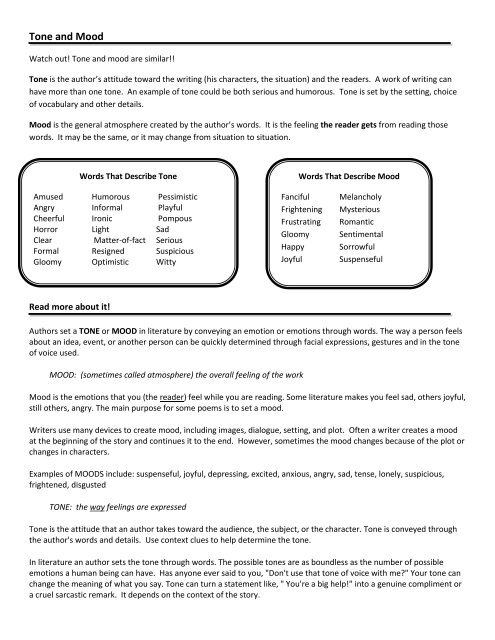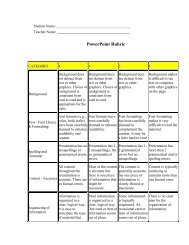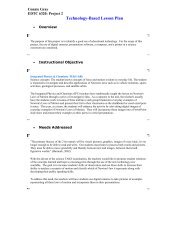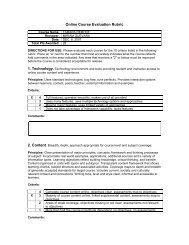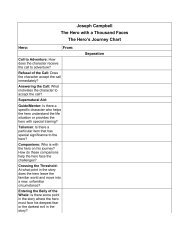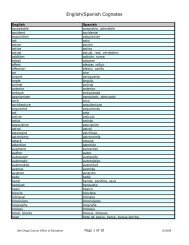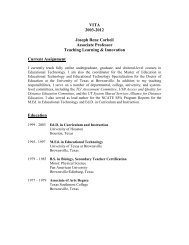Tone and mood worksheet
Tone and mood worksheet
Tone and mood worksheet
You also want an ePaper? Increase the reach of your titles
YUMPU automatically turns print PDFs into web optimized ePapers that Google loves.
<strong>Tone</strong> <strong>and</strong> Mood<br />
Watch out! <strong>Tone</strong> <strong>and</strong> <strong>mood</strong> are similar!!<br />
<strong>Tone</strong> is the author’s attitude toward the writing (his characters, the situation) <strong>and</strong> the readers. A work of writing can<br />
have more than one tone. An example of tone could be both serious <strong>and</strong> humorous. <strong>Tone</strong> is set by the setting, choice<br />
of vocabulary <strong>and</strong> other details.<br />
Mood is the general atmosphere created by the author’s words. It is the feeling the reader gets from reading those<br />
words. It may be the same, or it may change from situation to situation.<br />
Words That Describe <strong>Tone</strong><br />
Words That Describe Mood<br />
Amused Humorous Pessimistic<br />
Angry Informal Playful<br />
Cheerful Ironic Pompous<br />
Horror Light Sad<br />
Clear Matter-of-fact Serious<br />
Formal Resigned Suspicious<br />
Gloomy Optimistic Witty<br />
Fanciful<br />
Frightening<br />
Frustrating<br />
Gloomy<br />
Happy<br />
Joyful<br />
Melancholy<br />
Mysterious<br />
Romantic<br />
Sentimental<br />
Sorrowful<br />
Suspenseful<br />
Read more about it!<br />
Authors set a TONE or MOOD in literature by conveying an emotion or emotions through words. The way a person feels<br />
about an idea, event, or another person can be quickly determined through facial expressions, gestures <strong>and</strong> in the tone<br />
of voice used.<br />
MOOD: (sometimes called atmosphere) the overall feeling of the work<br />
Mood is the emotions that you (the reader) feel while you are reading. Some literature makes you feel sad, others joyful,<br />
still others, angry. The main purpose for some poems is to set a <strong>mood</strong>.<br />
Writers use many devices to create <strong>mood</strong>, including images, dialogue, setting, <strong>and</strong> plot. Often a writer creates a <strong>mood</strong><br />
at the beginning of the story <strong>and</strong> continues it to the end. However, sometimes the <strong>mood</strong> changes because of the plot or<br />
changes in characters.<br />
Examples of MOODS include: suspenseful, joyful, depressing, excited, anxious, angry, sad, tense, lonely, suspicious,<br />
frightened, disgusted<br />
TONE: the way feelings are expressed<br />
<strong>Tone</strong> is the attitude that an author takes toward the audience, the subject, or the character. <strong>Tone</strong> is conveyed through<br />
the author's words <strong>and</strong> details. Use context clues to help determine the tone.<br />
In literature an author sets the tone through words. The possible tones are as boundless as the number of possible<br />
emotions a human being can have. Has anyone ever said to you, "Don't use that tone of voice with me" Your tone can<br />
change the meaning of what you say. <strong>Tone</strong> can turn a statement like, " You're a big help!" into a genuine compliment or<br />
a cruel sarcastic remark. It depends on the context of the story.


